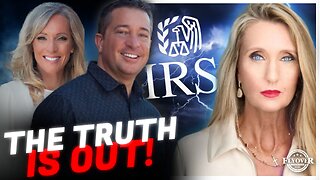Premium Only Content

Cash Flow Statement Basics Explained
28 January 2020 Unleash your inner Financial Pro
RESOURCES I Recommend: https://www.xelplus.com/resources/
The Cash Flow Statement is one of the 3 main Financial Statements. It will show you how effective a business is in managing its cash.
Most companies apply Accrual Accounting and it's important to understand that under this method revenue does not always equal cash in, and incurred expenses do not equal cash out. Therefore, don't make the mistake to just look at the income statement and the balance sheet. Focus on the Cash Flow Statement as well because it will show you where the company makes and spends its money.
The Cash Flow Statement consists of 3 main parts:
Cash Flow from Operations
Here we can find out how much cash a business is able to generate by selling its products and services. To calculate the Cash Flow from Operations there are 2 methods in use. In this video we will focus on the indirect method because it's used by most companies. It's linked to the income statement and starts with the Net Income. But in Accrual Accounting revenue does not equal cash in, and expenses do not equal cash out. Therefore, the net income from the Income statement must be adjusted to see the actual cash flows.
The most common adjustments are for non-cash transactions (depreciation, amortization, gains/losses for sales of non-current assets), and for working capital.
Cash Flow from Investing Activities
This shows the cash spent on investments or cash received from sales of investments. Here we can see the full cash inflow or outflow when a company purchases or sells property, equipment or other investments. We can also find out if the business acquired a company to expand its activities.
Cash Flow from Financing Activities
This section summarizes cash transactions that involve raising, borrowing, and repaying capital. When a company gets a bank loan or issues new shares it will receive additional cash. Therefore, this cash inflow will be reported with a positive figure. On the other hand, if the company repays the principal portion of a loan, pays dividends to its owners, or purchases its own shares it spends cash and reduces the cash balance. Therefore, this cash outflow will be reported with a negative figure.
At the very bottom of the Cash Flow Statement you will find the reconciliation to the cash balance in the Balance Sheet. The cash ending balance from the last period, plus the Cash Flows from Operations, Investing and Financing Activities must equal the cash ending balance for the current period. Sometimes, you will find an additional position for effects from foreign exchange rates caused by differences in average and spot rates.
00:00 How to Read a Cash Flow Statement
02:00 Cash Flow Statement - Overview
03:57 Cash Flow from Operating Activities
10:33 Cash Flow from Investing Activities
11:17 Cash Flow from Financing Activities
Check out the full article here: https://www.xelplus.com/cash-flow-statement-explained
In the next video of our accounting basics series, we'll see how to calculate the return for an investment.
★ My Online Excel Courses ► https://www.xelplus.com/courses/
✉ Subscribe & get my TOP 10 Excel formulas e-book for free
https://www.xelplus.com/free-ebook/
RESOURCES I Recommend: https://www.xelplus.com/resources/
Get Office 365: https://microsoft.msafflnk.net/15OEg
Microsoft Surface: https://microsoft.msafflnk.net/c/1327040/451518/7593
More resources on my Amazon page: https://www.amazon.com/shop/leilagharani
Let’s connect on social:
Instagram: https://www.instagram.com/lgharani
Twitter: https://twitter.com/leilagharani
LinkedIn: https://at.linkedin.com/in/leilagharani
Note: This description contains affiliate links, which means at no additional cost to you, we will receive a small commission if you make a purchase using the links. This helps support the channel and allows us to continue to make videos like this. Thank you for your support!
#Accounting #MsExcel #Excel #LeilaGharani
-
 3:17:30
3:17:30
Price of Reason
11 hours agoTrump Makes Waves! Disney Captain America HATES America! Selena Gomez MELTDOWN! Ubisoft CRUMBLES!
21.6K4 -
![[Tekken Tuesday] Its Time! Buckle Up Butter Cup!](https://1a-1791.com/video/fwe2/36/s8/1/I/U/S/e/IUSex.0kob-small-Tekken-Tuesday-Its-Time-Buc.jpg) 8:16:12
8:16:12
CHiLi XDD
10 hours ago[Tekken Tuesday] Its Time! Buckle Up Butter Cup!
60.3K4 -
 3:05:19
3:05:19
PandaSub2000
14 hours agoDuckTales Remastered | ULTRA BEST AT GAMES (Original Live Version)
88.4K -
 7:57:42
7:57:42
SpartakusLIVE
10 hours agoShadow BANNED Day 1 of NEW Season || Has WZ been FIXED?!?!
56.3K -
 1:19:42
1:19:42
Glenn Greenwald
11 hours agoLab Leak Revelations Prove Corrupt Suppression of COVID Dissent; CNN Boots Jim Acosta: Who & What is a "Journalist"? | SYSTEM UPDATE #398
83.4K103 -
 1:11:00
1:11:00
Donald Trump Jr.
15 hours agoFirst White House Press Briefing, Plus Behind the Scenes on Capitol Hill w/ Rep Vince Fong & Sen Eric Schmitt | TRIGGERED Ep.211
202K173 -
 1:45:52
1:45:52
Redacted News
12 hours agoBOMBSHELL! Trump about to announce largest spending FREEZE in American history, deep state in PANIC
234K393 -
 1:05:23
1:05:23
Man in America
15 hours agoDeepSeek & the AI War to Dominate the New World Order w/ Mike Adams
67.8K21 -
 2:50:20
2:50:20
DLDAfterDark
7 hours ago $3.43 earnedDLD Live! Are They Planning an Attack?? The "cute winter boots" Trend & What it Means!
35.1K5 -
 55:26
55:26
Flyover Conservatives
1 day agoFrom Conspiracy Theory to Proven Fact: Breaking Free from the American Corporation - Ann Vandersteel | FOC Show
48.2K8